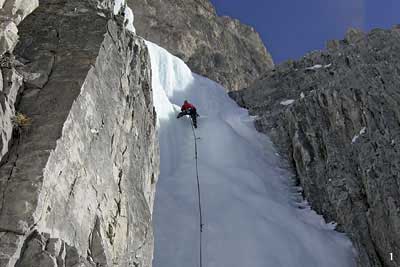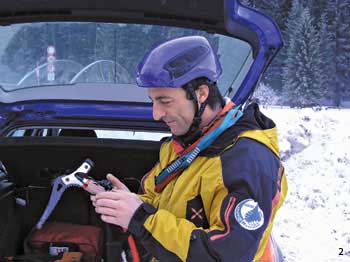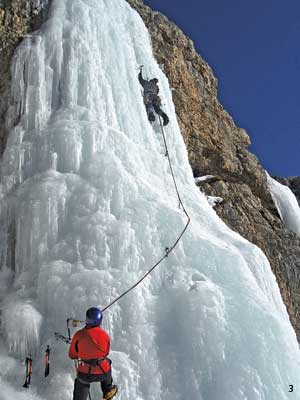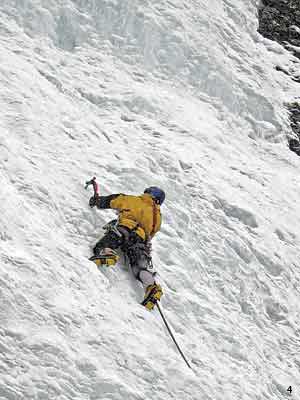| |
Ice climbing: passion in unforgettable landscape
Alberto Salogni
 The previous issue of “Eco delle Dolomiti” was dedicated to water, in this issue we can talk about when this element solidifies, creating structures that mountaineers love to climb. Frozen waterfall climbing is different from rock climbing. First of all, ice is an extremely changeable element. Depending on the way it’s facing, the temperature and humidity, the conditions can change in only a few hours. A waterfall in excellent conditions in the morning can suddenly collapse in the afternoon, merely because warm wind has started to blow. In the Fiemme and Fassa valleys there are many frozen structures that allow slow climbs of up to 200 metres at various levels of difficulty. Some are located at high altitude, especially in the Sella and Sassolungo ranges, but also others are more or less on the valley floor and are easily accessed. In the area underlying Passo Mànghen pass there are some lovely waterfalls, such as Predazzo above, and others in the surrounding areas of Fontanazzo and Campitello di Fassa. In Fontanazzo, where the Avisio flows in winter, you can note two types of sport’s person: those in tight colourful outfits who race on cross-country skis in order to prepare themselves for the Marcialonga cross-country ski marathon and the other type with enormous rucksacks filled with rope, crampons, picks and ice screws, heading toward the frozen rivers. They are two different sports but both very arduous. I The previous issue of “Eco delle Dolomiti” was dedicated to water, in this issue we can talk about when this element solidifies, creating structures that mountaineers love to climb. Frozen waterfall climbing is different from rock climbing. First of all, ice is an extremely changeable element. Depending on the way it’s facing, the temperature and humidity, the conditions can change in only a few hours. A waterfall in excellent conditions in the morning can suddenly collapse in the afternoon, merely because warm wind has started to blow. In the Fiemme and Fassa valleys there are many frozen structures that allow slow climbs of up to 200 metres at various levels of difficulty. Some are located at high altitude, especially in the Sella and Sassolungo ranges, but also others are more or less on the valley floor and are easily accessed. In the area underlying Passo Mànghen pass there are some lovely waterfalls, such as Predazzo above, and others in the surrounding areas of Fontanazzo and Campitello di Fassa. In Fontanazzo, where the Avisio flows in winter, you can note two types of sport’s person: those in tight colourful outfits who race on cross-country skis in order to prepare themselves for the Marcialonga cross-country ski marathon and the other type with enormous rucksacks filled with rope, crampons, picks and ice screws, heading toward the frozen rivers. They are two different sports but both very arduous. I love living in these valleys because all winter sports can take place here. And what could be nicer than being passionate about an outdoor sport? Ok, climbing up a frozen waterfall is not a joke and can be very dangerous. Often the waterfalls are located in very dark ravines where the sun never shines. Often your mobile has no signal when it’s needed or if there’s an accident you can go into hypothermia. When it says fifteen degrees below zero on the barometer, it’s hard to say “let’s go” but when you reach your goal every effort is forgotten and everything seems wonderful: ice climbing allows you to see incredible shapes and colours. Some scenery is so surreal that sometimes it’s like being on another planet; and the mountaineer is part of it all, being on the inside. My last climb last winter is one of my favourites: Rio Pelòus in Campitello di Fassa, right behind the del Col Rodella cable railway. love living in these valleys because all winter sports can take place here. And what could be nicer than being passionate about an outdoor sport? Ok, climbing up a frozen waterfall is not a joke and can be very dangerous. Often the waterfalls are located in very dark ravines where the sun never shines. Often your mobile has no signal when it’s needed or if there’s an accident you can go into hypothermia. When it says fifteen degrees below zero on the barometer, it’s hard to say “let’s go” but when you reach your goal every effort is forgotten and everything seems wonderful: ice climbing allows you to see incredible shapes and colours. Some scenery is so surreal that sometimes it’s like being on another planet; and the mountaineer is part of it all, being on the inside. My last climb last winter is one of my favourites: Rio Pelòus in Campitello di Fassa, right behind the del Col Rodella cable railway.
Anyone can try one’s hand at ice climbing, the important thing is not to leave anything to chance and only trust skilled professionals, or there are courses organised by CAI or Alpine guides. Once you’ve learned the rudiments, you can organise things and progress very slowly with a friend: You can’t miss out on the exhilaration of ice climbing, ice just won’t wait!
 “The first 50 metres are over an ice plate at 85°. The tips of the ice picks and crampons dig in into the porous ice well. Every so often, I put in an ice crampon to prevent falls. With all these sharpened steel spikes we carry, even a fall of a few metres can be dangerous. The circulation is coming back into my hands so they are really starting to hurt. I hate these “little circulation devils” as they often attack on every climb. I can put my hard frozen gloves back on as the circulation is back, you get used to the method: a small squeeze to get the water out so you can put them on again. “The first 50 metres are over an ice plate at 85°. The tips of the ice picks and crampons dig in into the porous ice well. Every so often, I put in an ice crampon to prevent falls. With all these sharpened steel spikes we carry, even a fall of a few metres can be dangerous. The circulation is coming back into my hands so they are really starting to hurt. I hate these “little circulation devils” as they often attack on every climb. I can put my hard frozen gloves back on as the circulation is back, you get used to the method: a small squeeze to get the water out so you can put them on again.  I look at the second rope length’s distance: it’s a huge vertical icicle. For the first few metres I go behind, being detached from the rock by a pair of metres and then I take it on right in the centre with a lot of arm work. At the top, I climb in layback between rock and ice. My back is resting on the vertical rock, while the front spikes of the crampons and the blade of the small picks are stuck into the ice in front of me. The ropes are hanging freely in space under me and looking between my feet I see my climbing partner 50 metres below, stopped on an ice terrace, ready to stop the ropes if I fall. I can’t put protection screws because the layer of ice on the rock is no thicker than 5 centimetres. But it’s thrilling, beautiful, and the higher I climb the freer and lighter I feel …like the ice itself”. I look at the second rope length’s distance: it’s a huge vertical icicle. For the first few metres I go behind, being detached from the rock by a pair of metres and then I take it on right in the centre with a lot of arm work. At the top, I climb in layback between rock and ice. My back is resting on the vertical rock, while the front spikes of the crampons and the blade of the small picks are stuck into the ice in front of me. The ropes are hanging freely in space under me and looking between my feet I see my climbing partner 50 metres below, stopped on an ice terrace, ready to stop the ropes if I fall. I can’t put protection screws because the layer of ice on the rock is no thicker than 5 centimetres. But it’s thrilling, beautiful, and the higher I climb the freer and lighter I feel …like the ice itself”.
(excerpt from “Uomini in verticale” (Vertical Men), by Alberto Salogni , Editrice Uni-Service publisher , Trento 2007)
- Bands of ice between the rocks. In the photo, Alberto Salogni opens up a new path on the waterfall in the Catinaccio range (Val di Fassa).
- Equipment check before attacking a 200 metre waterfall in Campitello.
- A break, supported by ice screws (Siloga at Catinaccio waterfall).
- Climbing even as it’s snowing.
|
|